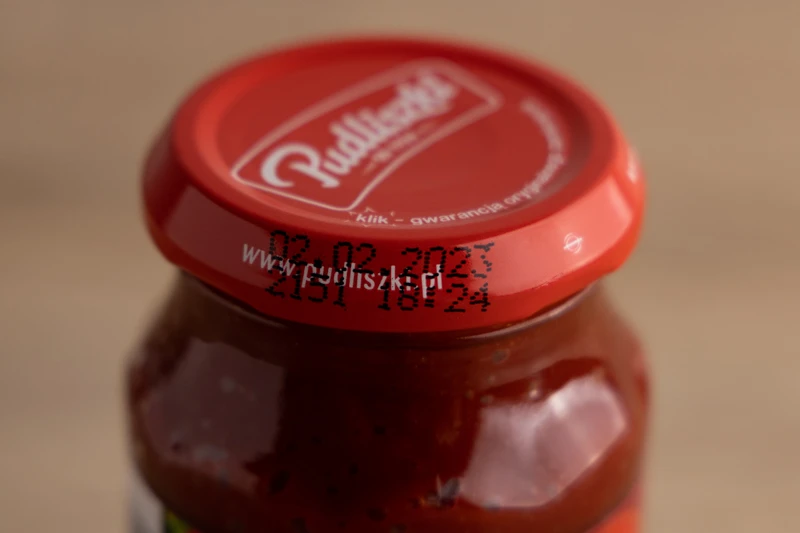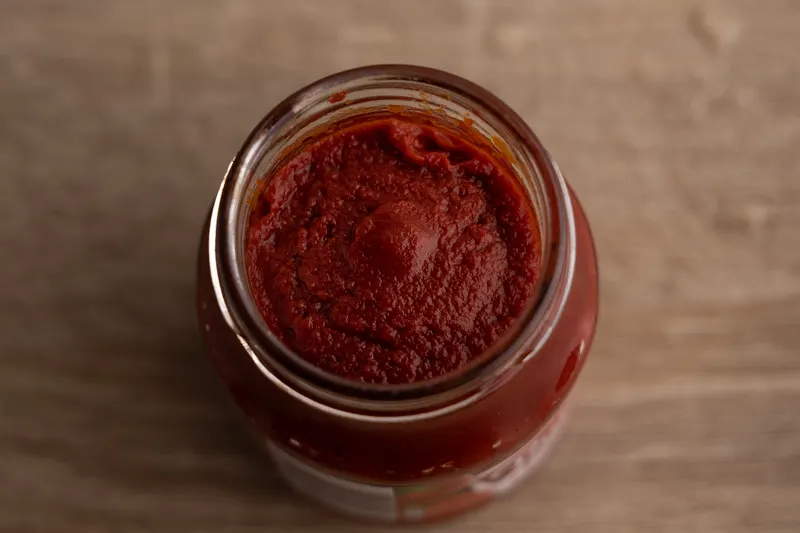In a Nutshell:
- Shelf life: Unopened tomato paste can last up to 18-24 months; opened paste lasts 5-7 days in the fridge or up to 45 days if it’s a tube.
- Spoilage signs: Mold, off-smell, discoloration, and changes in texture indicate spoilage.
- Storage methods: Refrigerate opened paste in airtight containers; freeze for long-term storage.
Are you one of the many people who find themselves with half-used cans of tomato paste, wondering: “Does tomato paste go bad?.”
This article is here to help you make the most of this versatile ingredient while ensuring food safety. Dive into our comprehensive guide on tomato paste shelf life, spoilage, and storage methods.
We’ll share tips and tricks for keeping your paste fresh and ready to use and how to tell if tomato paste is bad.
By the time you’re finished reading, you’ll be a tomato paste expert, and those half-used cans will never go to waste again!

Table of Contents
- How Long Does Tomato Paste Last?
- How to Tell if Tomato Paste Is Bad?
- Debunking Worries: Harmless Changes in Tomato Paste
- How to Store Tomato Paste
How Long Does Tomato Paste Last?
Unopened canned tomato paste has a shelf life of 18-24 months, while opened paste lasts 5-7 days in the refrigerator. If it’s tomato paste in a tube, it can last up to 45 days.
Unopened Tomato Paste
Unopened canned tomato paste lasts a long time because it’s a canned product. And as long as the can or glass jar is stored properly and the seal is untouched, the paste should stay safe to eat.
Of course, there’s a best-by date on the label, but it’s more about the quality of the product than safety. The quality degrades slowly over time, so if the paste is more than a couple of months past the “expiration” date, its flavor might not be as good as that of a fresh paste.

Opened Tomato Paste
Once opened, tomato paste’s shelf life decreases considerably, with a general guideline of 5-7 days in the refrigerator. Tomato paste in a tube is an exception, as these can retain quality for up to 45 days.
So if you buy tomato paste in tubes, you pay more but get a product with a noticeably longer shelf life.
Check the label to ensure how long your leftover tomato paste lasts. The 45 days example I mentioned comes from one brand, and I cannot guarantee every other one lasts as long.
This short storage time is because exposure to air and bacteria can cause the paste to spoil.
To extend the life of your opened tomato paste and make sure it doesn’t dry out, transfer it to an airtight container before refrigerating. This minimizes contact with air and potential contaminants.
(Obviously, if yours comes in a glass jar, there’s no need to transfer it.)
Additionally, you can freeze tomato paste, which will keep it fresh for another 6-8 months.
Homemade Tomato Paste
Homemade tomato paste lasts 3 to 4 days in the fridge, just like any other perishable good. If you want to make a large batch, freezing tomato paste is the way to go.
To freeze tomato paste, you can divide it into dish-sized portions and freeze it in containers or freezer bags, or use ice cube trays. When going with the latter, pre-freeze the leftover tomato paste in the trays, then transfer the cubes into a plastic bag to freeze for the long term.
If you usually need larger amounts of tomato paste, use a muffin tray or two instead of ice cube trays.
Knowing that, let’s talk about spoilage signs.
How to Tell if Tomato Paste Is Bad?
To determine if tomato paste has gone bad, look for signs such as mold, an off-smell, discoloration, and changes in texture. If you notice any of these indicators, it’s best to discard the paste and avoid consumption.
- Mold. Mold growth is a clear sign of spoilage in tomato paste and many other condiments, such as ketchup, mustard, and BBQ sauce. If you see any mold on the surface, in the container, or around the lid, it’s time to throw the paste away.
- Off-smell. A foul or sour odor is another sign that your tomato paste has gone bad. Fresh tomato paste should have a tangy, slightly sweet aroma. If it smells sour, off, or generally unpleasant, maybe similar to spoiled mayonnaise or salad dressing, discard it.
- Discoloration. Tomato paste should have a deep, vibrant red color. If it appears super dull or has any unusual color changes (that aren’t mold growth), it’s likely no longer safe to consume. Slight browning is an exception, which I will cover in the next section. Discoloration can also be a sign of spoilage in other condiments like horseradish sauce, but it is perfectly normal in others, like browning in hot sauce.
- Changes in Texture. Fresh tomato paste has a thick, smooth consistency. If you notice it becoming clumpy or separated, it may be a sign that the paste is no longer good. Of course, slight separation is okay and expected after a few days of storage.
Always pay attention to these signs to ensure the freshness and safety of your concentrated tomato sauce. By doing so, you’ll be able to enjoy delicious meals made with this versatile ingredient without any concerns.

Debunking Worries: Harmless Changes in Tomato Paste
Tomato paste can undergo some changes that may seem concerning but are actually harmless. Understanding these changes will help you use your tomato paste confidently and safely in your favorite cooked dishes.
Here are the most common examples:
Darkening at the Top
Over time, tomato paste may darken near the surface due to oxidation. This is similar to what you may see in ketchup or Tabasco sauce.
A slight darkening is normal and doesn’t mean the paste has spoiled. Give the paste a stir to blend the color evenly, and it’s ready to use.
Separation
When tomato paste sits for a while, you might notice some separation, with a watery layer forming on top. This is a natural process and also occurs in products.
Gently stir the paste to recombine the ingredients, and it will be good to go.
Thickening
Tomato paste can become slightly thicker over time, especially if it has been exposed to air and some of the water content has evaporated. This is a normal reaction and doesn’t necessarily indicate that the product is bad.
The same thickening can happen with condiments like Worcestershire sauce and soy sauce, especially if they’ve been left open for an extended period.
Just be aware that thicker paste means concentrated flavor, so adjust the amount used in your recipes accordingly.
In summary, some changes in tomato paste might seem worrisome but are actually harmless. By learning about these, you can confidently use your tomato paste without any concerns about its quality or safety.

How to Store Tomato Paste
Here’s how to store tomato paste:
- A cold and dark place. An unopened tomato paste should sit in a cool and dry place, away from any heat sources.
- Transfer to an airtight container: After opening a can of tomato paste, it’s best to transfer the unused portion to an airtight container. This minimizes the paste’s exposure to air, which can cause it to spoil more quickly. This doesn’t apply if yours comes in a glass jar or a tube, obviously.
- Label and date the container: To keep track of your tomato paste’s freshness, it’s a good idea to label the container with the date you opened it. This way, you’ll know how long it’s been stored and can refer to the recommended shelf life for opened paste. I often have a half-opened jar in the fridge, and without labeling, it’s almost impossible to tell how long it’s been there.
- Refrigerate or freeze: After opening, place the leftover tomato paste in the refrigerator. If you plan to store the paste for longer, consider freezing it in small portions using an ice cube tray or individual freezer containers or bags.
By following these storage guidelines, you can ensure the freshness and quality of your tomato paste, making it a versatile and reliable ingredient in your kitchen.